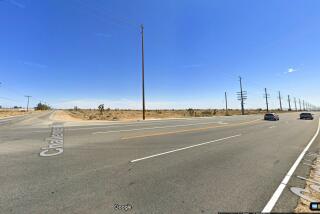CHP to Replace Air Fleet in Fight Against Traffic Jams
- Share via
SACRAMENTO — The California Highway Patrol is replacing its aging squadron of 14 airplanes as the state intensifies its battle against traffic congestion.
It is buying new planes, some of which will be equipped with high-tech video cameras that will provide finely detailed live images of actual or potential problems to officers on the ground.
One of the 14 new Cessna T-206Hs will be assigned, at least experimentally, to join helicopters in regularly patrolling the traffic-choked Los Angeles Basin, a first for the CHP.
“I’d be greatly surprised if the [test] doesn’t succeed,” said CHP Commissioner D.O. “Spike” Helmick, who supervised the $5.3-million aircraft deal with a federal highway safety grant.
The fleet’s oldest plane was built in 1978 and its newest in 1984. Some have logged more than 22,000 hours, and all but a few were bought secondhand.
As congestion in the nation’s most populous and automobile-saturated state has steadily worsened, the patrol’s fleet of Cessna 185s has remained unchanged since 1984, said Capt. Tim Clark, commander of air operations.
Sixteen years ago, the state’s population totaled only 25 million compared with about 35 million now. During the same period, the number of licensed drivers swelled from 17 million to more than 21 million.
Today, more than 24 million vehicles are registered in California. Countless millions of cars and trucks from other states also use California streets and highways.
Over the next several months, the new planes will be distributed to CHP regions throughout California for duties ranging from congestion relief and traffic law enforcement to surveillance, emergency medical aid, and search and rescue.
They will augment a fleet of nine helicopters, whose duties are concentrated in urban areas.
In an interview last week, Helmick conceded that the new planes will not satisfy all demands, but he said they should relieve the CHP of the heavy costs of maintaining the aging aircraft.
“These airplanes are like keeping an old car. They are nice, but they are expensive to keep running,” Helmick said.
Replacement parts for the Cessna 185, which is no longer made, are expensive and very difficult to find. Just locating a replacement windshield or cable could mean grounding the aircraft for weeks.
“The down time is killing us,” said Dick Rushton, chief maintenance coordinator.
Clark and other officers indicated that the unplanned maintenance has cut into the fleet’s operations. But with the new planes, “we are projecting that we will be able to fly 38% more hours,” he said.
Helmick indicated that in urban regions a first line of attack for the airplanes, which can fly faster and higher than the current ones, will be relief of congestion.
“Originally, airplanes were used for speed enforcement. But there is a bigger role now. We have to get people to work and home again,” he said.
Helmick said pilots will be in close communication with a special force of 76 new motorcycle officers whose primary duty will be to break up traffic congestion during commute times.
Every new plane will be equipped with an improved radio and a global positioning system that will enable officers to pinpoint locations.
Some also will be fitted with sophisticated video cameras, from which live images can be transmitted to law enforcement agencies and traffic managers on the ground.
“You can literally read the newspaper sitting on the seat of a car,” Helmick said.
The sprawling Los Angeles Basin traditionally has depended on CHP, police and sheriff’s helicopters for duty in the sky. But this may change.
Starting next month, one of the new airplanes will be assigned to the basin in a test to decide whether it should become a permanent CHP feature.
“The population growth of the L.A. basin has spread so much and people are commuting much longer distances,” said chief pilot Sgt. Kirk Chaney. “Our planes are much faster than helicopters. It’s important to get to an incident as quickly as possible.”
More to Read
Sign up for Essential California
The most important California stories and recommendations in your inbox every morning.
You may occasionally receive promotional content from the Los Angeles Times.










